

Deep diving scientists discover bubbling CO2 hotspot. Diving 200 feet under the ocean surface to conduct scientific research can lead to some interesting places.

For University of Texas at Austin Professor Bayani Cardenas, it placed him in the middle of a champagne-like environment of bubbling carbon dioxide with off-the-chart readings of the greenhouse gas. Geologists Baffled By “Massive Anomalies” at Edge of Earth’s Core. Hidden Island At the edge of the Earth’s core lie two gigantic blobs of ultrahot rock — and that’s about the extent to which geologists agree about them.

The mysterious blobs sit on opposite ends of the planet, one is hiding beneath Africa, the other in the middle of the Pacific Ocean — Quanta Magazine compared the “massive anomalies” to Princess Leia’s iconic hair buns. Scientists first discovered the blobs decades ago while mapping the planet’s interior, but haven’t learned much since. Some Ideas There are two main schools of thought regarding the blobs, according to Quanta. Recent evidence supports the second camp: Quanta reports that scientists found traces of unique, ancient rocks and isotopes in magma that’s flowed upward from the blobs — materials nearly as old as the Earth itself and not found elsewhere on the planet. Öhringen. Place in Baden-Württemberg, Germany With a population of 22,745 (2009), the town is diverse.
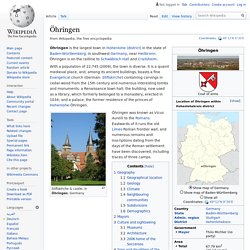
It is a quaint medieval place, and, among its ancient buildings, boasts a fine Evangelical church (German: Stiftskirche) containing carvings in cedar-wood from the 15th century and numerous interesting tombs and monuments; a Renaissance town hall; the building, now used as a library, which formerly belonged to a monastery, erected in 1034; and a palace, the former residence of the princes of Hohenlohe-Öhringen. Stiftskirche & castle, in Öhringen, Germany Öhringen was known as Vicus Aurelii to the Romans. Eastwards of it runs the old Limes Roman frontier wall, and numerous remains and inscriptions dating from the days of the Roman settlement have been discovered, including traces of three camps.
Geography[edit] Geographical location[edit] Forces from Earth's spin may spark earthquakes and volcanic eruptions at Mount Etna. New research suggests forces pulling on Earth's surface as the planet spins may trigger earthquakes and eruptions at volcanoes.
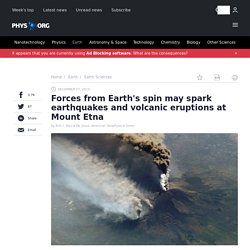
Seismic activity and bursts of magma near Italy's Mount Etna increased when Earth's rotational axis was furthest from its geographic axis, according to a new study comparing changes in Earth's rotation to activity at the well-known Italian volcano. Earth's spin doesn't always line up perfectly with its north and south poles. Instead, the geographic poles often twirl like a top around Earth's rotational axis when viewed from space.
Every 6.4 years, the axes line up and the wobble fades for a short time—until the geographic poles move away from the spin axis and begin to spiral once again. This phenomenon, called polar motion, is driven by changes in climate due to things like changing seasons, melting ice sheets or movement from tectonic plates. Antarctica Week Five: Halfway There. The stellar weather continues for Antarctica’s man and woman haulers.
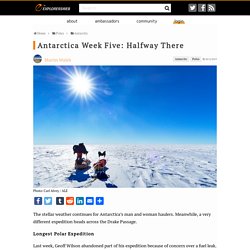
Meanwhile, a very different expedition heads across the Drake Passage. Mysterious tectonic fault zone found off California. Prehistoric Zodiacal Dating Code Revealed At Göbekli Tepe. Archaeologists agree, Göbekli Tepe changes everything.
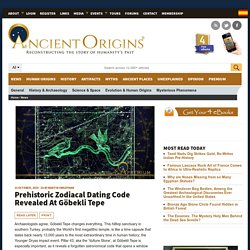
This hilltop sanctuary in southern Turkey, probably the World’s first megalithic temple, is like a time capsule that dates back nearly 13,000 years to the most extraordinary time in human history; the Younger Dryas impact event. Pillar 43, aka the ‘Vulture Stone’, at Göbekli Tepe is especially important, as it reveals a forgotten astronomical code that opens a window into the minds of ancient people, going back perhaps over 40,000 years. A code that allows one to read about catastrophic events, like the Younger Dryas impact, that is probably the basis of nearly all the world’s religions.
There could hardly be a more important discovery. Göbekli Tepe, southern Turkey, ( Teomancimit / CC BY-SA 3.0 ) Pillar 43 is like a pre-historic Rosetta Stone. While this discovery is profound, by uncovering this ancient astronomical code one is able to decode much more than just Göbekli Tepe. Beauty Carved by Nature’s Violence. This photograph of the Alaskan Peninsula, shot by an astronaut from the International Space Station (ISS), offers an oblique view of Katmai National Park.
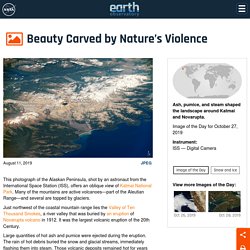
Many of the mountains are active volcanoes—part of the Aleutian Range—and several are topped by glaciers. Just northwest of the coastal mountain range lies the Valley of Ten Thousand Smokes, a river valley that was buried by an eruption of Novarupta volcano in 1912. It was the largest volcanic eruption of the 20th Century. Large quantities of hot ash and pumice were ejected during the eruption. Earthquakes in slow motion: Studying 'slow-slip' events could shed light on destructive temblors. A new study from Caltech finds that so-called "slow slip" or "silent" earthquakes behave more like regular earthquakes than previously thought.
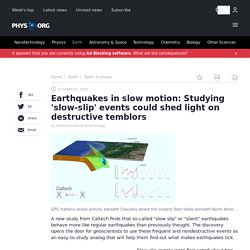
The discovery opens the door for geoscientists to use these frequent and nondestructive events as an easy-to-study analog that will help them find out what makes earthquakes tick. Slow-slip events were first noted about two decades ago by geoscientists tracking otherwise imperceptible shifts in the earth using GPS technology. They occur when faults grind incredibly slowly against each other, like an earthquake in slow motion. 600M-year-old ice age caused 'Snowball Earth,' radically changing planet's climate. Researchers have discovered a massive ice age more than 600 million years ago radically altered the planet's climate, resulting in a "Snowball Earth.

" The study, published last month, notes that the ice age left the planet "a barren, flooded landscape" with "clear oceans," according to how carbonate sedimentary rocks formed over millions of years after the Snowball Earth. "It was previously thought that these distinctive carbonate rocks were deposited over less than 10 thousand years, as the sea level rose when the ice that covered the entire globe melted, but we have shown that they were likely deposited over hundreds of thousands to millions of years following the sea-level rise," the study's lead author, Adam Nordsvan, said in a statement.
"There is already some evidence that suggested these rocks took a long time to form, but no one had been able to explain why this might have occurred," Nordsvan continued. The research has been published in the scientific journal Terra Nova. Archaeologist Plans to Map All Land on Earth Using Lasers on Planes Before Climate Change Claims Treasures. Cultural, environmental and geological treasures are already being lost to climate change.Using Lidar, a scientist wants to create a 3D map of all the land on Earth.He also wants to create a repository to share data will all researchers.

Using lasers aboard planes, a Colorado State University archaeologist wants to scan the entire surface of the Earth and create detailed digital maps of all its treasures. Chris Fisher is racing against time. Climate change is already altering many of the features Fisher wants to record. Archaeologists reveal face of Egyptian princess that lived almost 4,000 years ago. Archaeologists have revealed the face of an Egyptian princess who lived almost 4,000 years ago by painstakingly piecing together the wooden shards of her sarcophagus. The fragments expose the likeness of a royal, possibly Princess Hatshepset, daughter of Pharaoh Ameny Qemau, who lived towards the end of Egypt's Middle Kingdom. Her image will be seen for the first time on Channel 4's Egypt's Lost Pyramid programme, which follows the two-year excavation and study of the royal's final resting place.
Russian volcano eruption has caused rare purple sunsets all over the world. Volcanic eruptions can often be devastating to nearby regions, but a remote volcano in Russia is responsible for some beautiful sunsets, according to researchers. The volcano Raikoke shot aerosols into the air in June, ones that Lars Kalnajs, a research associate at the University of Colorado, says are responsible for turning the sky a purple hue in different parts of the globe. “It makes you realize that you don’t have to put a whole lot of aerosols into the stratosphere to change its composition,” Kalnajs said in a statement. “This was a relatively small volcanic eruption, but it was enough to impact most of the northern hemisphere.” The level of aerosols that Raikoke's eruption released into the air were 20 times thicker than normal, Kalnajs and his colleagues found.
The final results will be published in a journal later this year. Hidden continent called Greater Adria sits under modern-day Europe. Archaeological Discoveries Proving GIANTS exist. Redirect Notice. Making Sense of Big Data With Virtual Reality And The Unconscious Mind. 3,789 views|Aug 16, 2014,10:18 am A single death is a tragedy; a million deaths is a statistic, is a well-known quote – often mistakingly attributed to Stalin. Regardless of the author, the sentence is interesting because it can be read in at least two ways: in one, it relates with compassion fatigue, our inability to feel outrage when the horror surpasses a certain threshold.
But it might also be seen as pointing to our inability to visualize and grasp the meaning of huge data amounts. When numbers are too high, the mind struggles to make sense of them. If, instead of a single number, you deal with large datasets, it’s difficult to find meaningful patterns that characterize them. Or when it is, it would take too much time to do so. Using the eXperience Induction Machine (XIM), an immersive multi-modal environment located at Pompeu Fabra University in Barcelona, they are trying to use virtual reality to enable users to ‘step inside’ large datasets. German Speaking Austrian. Tokelau. Guqm. French southern and antarctic lands. French southern and antarctic lands.